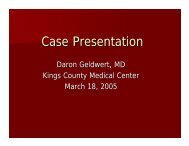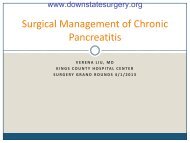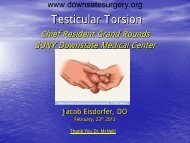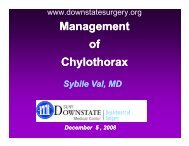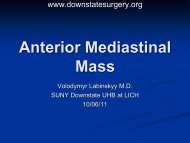Techniques for Splenic Salvage - Department of Surgery at SUNY ...
Techniques for Splenic Salvage - Department of Surgery at SUNY ...
Techniques for Splenic Salvage - Department of Surgery at SUNY ...
You also want an ePaper? Increase the reach of your titles
YUMPU automatically turns print PDFs into web optimized ePapers that Google loves.
www.downst<strong>at</strong>esurgery.org<br />
<strong>Techniques</strong> <strong>for</strong><br />
<strong>Splenic</strong> <strong>Salvage</strong><br />
Feiran Lou<br />
Kings County Hospital Center<br />
<strong>Department</strong> <strong>of</strong> <strong>Surgery</strong>
www.downst<strong>at</strong>esurgery.org<br />
Case<br />
• 44 yo woman with unknown PMH s/p<br />
pedestrian struck BIBEMS, mangled left leg<br />
• GCS 4/5/6<br />
• VS Afebrile, BP 60-70’s/40’s, HR 100’s, RR<br />
30’s, 100%<br />
• Intub<strong>at</strong>ed in trauma bay<br />
• Resuscit<strong>at</strong>ion with 3 L crystalloids, 4 u PRBC<br />
• CXR, Pelvis XR
www.downst<strong>at</strong>esurgery.org
www.downst<strong>at</strong>esurgery.org
www.downst<strong>at</strong>esurgery.org
www.downst<strong>at</strong>esurgery.org<br />
Work Up Cont.<br />
• Labs<br />
– CBC 9.01/10.6/33.0/278<br />
– VBG 7.27/49/29/19.8/-3.9/43%<br />
– BMP, LFT, coags WNL<br />
• FAST +
www.downst<strong>at</strong>esurgery.org<br />
Intraoper<strong>at</strong>ive Course<br />
• Hypotensive SBP 70-90’s<br />
• LLE tourniquet applied<br />
• Explor<strong>at</strong>ory laparotomy: ~100 cc gross<br />
blood, 2-3 cm lacer<strong>at</strong>ion ant. superior pole<br />
<strong>of</strong> spleen with moder<strong>at</strong>e oozing. BioGlue<br />
applied. Spleen packed.<br />
• Left open AKA
www.downst<strong>at</strong>esurgery.org<br />
Intraoper<strong>at</strong>ive Course<br />
• Abdomen<br />
– Packs removed<br />
– Spleen fully mobilized<br />
– Large posterior stell<strong>at</strong>e lacer<strong>at</strong>ion<br />
– Splenectomy<br />
• Left chest tube<br />
• 2 units pRBC<br />
• 2 FFP
www.downst<strong>at</strong>esurgery.org<br />
Post Oper<strong>at</strong>ive Course<br />
• POD 1 Continued resuscit<strong>at</strong>ion in SICU<br />
• POD 2 Hemodynamically stable<br />
• Toler<strong>at</strong>ed diet<br />
• Left AKA stump revised POD 8<br />
• Vaccin<strong>at</strong>ions POD 13<br />
• Discharged on POD 15
www.downst<strong>at</strong>esurgery.org<br />
Historical Perspective<br />
• 1738 John Ferguson: partial splenectomy<br />
• 1910 Mayo “the internal secretion <strong>of</strong> the spleen is<br />
not important, as splenectomy does not produce<br />
serious results.” ↑↑ splenectomies<br />
• 1952 Post splenectomy syndrome in 4/5 children<br />
severe/f<strong>at</strong>al meningitis + sepsis<br />
• 1969 Overwhelming post splenectomy infection<br />
(OPSI) <strong>Splenic</strong> preserv<strong>at</strong>ion
www.downst<strong>at</strong>esurgery.org<br />
Historical Perspective cont.<br />
• Spleen salvage popularized in 1960-70’s<br />
by pedi<strong>at</strong>ric surgeons
www.downst<strong>at</strong>esurgery.org<br />
<strong>Splenic</strong> Function<br />
1. Antibody Production<br />
Encapsul<strong>at</strong>ed Gm +<br />
2. Factors in immune<br />
response: opsonins<br />
complement<br />
activ<strong>at</strong>ion<br />
3. Filtr<strong>at</strong>ion: blood cells,<br />
particul<strong>at</strong>e m<strong>at</strong>ters<br />
4. Sequestr<strong>at</strong>ion: RBCs<br />
and pl<strong>at</strong>elets
www.downst<strong>at</strong>esurgery.org
www.downst<strong>at</strong>esurgery.org
www.downst<strong>at</strong>esurgery.org
www.downst<strong>at</strong>esurgery.org
www.downst<strong>at</strong>esurgery.org<br />
<strong>Splenic</strong> Injury<br />
Small subcapsular hem<strong>at</strong>oma (3 cm deep or involving<br />
trabecular vessels)
www.downst<strong>at</strong>esurgery.org<br />
<strong>Splenic</strong> Injury<br />
Lacer<strong>at</strong>ion involving segmental or<br />
hilar vessels producing major<br />
devasculariz<strong>at</strong>ion (>25% <strong>of</strong> spleen)<br />
Sh<strong>at</strong>tered or devascularized spleen
www.downst<strong>at</strong>esurgery.org<br />
Assessment <strong>of</strong> Spleen<br />
Mobiliz<strong>at</strong>ion is key!!!
www.downst<strong>at</strong>esurgery.org<br />
Grade I<br />
• Hemost<strong>at</strong>ic agents<br />
– Micr<strong>of</strong>ibrillar collagen<br />
– Gel<strong>at</strong>in sponge<br />
– Fibrin glue<br />
– Packing
www.downst<strong>at</strong>esurgery.org<br />
Grade II and III<br />
1. Argon beam<br />
2. Suture:<br />
mon<strong>of</strong>ilaments<br />
(i.e. 2.0 chromic)<br />
pledget m<strong>at</strong>erials<br />
• Horizontal<br />
m<strong>at</strong>tress vs.<br />
continuous vs<br />
figure <strong>of</strong> 8’s<br />
Electrocautery <strong>of</strong><br />
spleen rarely helpful!!
www.downst<strong>at</strong>esurgery.org<br />
Grade IV<br />
• Partial splenectomy
www.downst<strong>at</strong>esurgery.org<br />
Partial Splenectomy
www.downst<strong>at</strong>esurgery.org<br />
Grade IV<br />
• Omental pedicle and peritoneal p<strong>at</strong>ch
www.downst<strong>at</strong>esurgery.org<br />
Grade IV<br />
• Absorbable mesh
www.downst<strong>at</strong>esurgery.org<br />
Grade IV<br />
• Autotransplant <strong>of</strong> splenic tissue
www.downst<strong>at</strong>esurgery.org<br />
Post Oper<strong>at</strong>ive Complic<strong>at</strong>ions<br />
• Bleeding<br />
• Gastric distention<br />
• Gastric necrosis – lig<strong>at</strong>ion <strong>of</strong> short<br />
gastrics, uncommon<br />
• Pancre<strong>at</strong>ic injury
www.downst<strong>at</strong>esurgery.org<br />
• Level I trauma center<br />
• 1980-1989<br />
• 240 adults underwent splenorrhaphy (43% <strong>of</strong><br />
all splenic injuries)<br />
• 86% per<strong>for</strong>med on grades I-III<br />
• 83% <strong>of</strong> repairs were simple suture w/ or w/o<br />
topical agents
www.downst<strong>at</strong>esurgery.org<br />
Postoper<strong>at</strong>ive Complic<strong>at</strong>ions<br />
• 3 (1.3%) postoper<strong>at</strong>ive bleeding <br />
splenectomy<br />
• Total 6 de<strong>at</strong>hs (2.6%), one from<br />
subphrenic abscess and septic shock<br />
• Other complic<strong>at</strong>ions: subphrenic abscess<br />
(3), drain abscess (1), dehiscence (1),<br />
early SBO (2), wound infections (2)
www.downst<strong>at</strong>esurgery.org
www.downst<strong>at</strong>esurgery.org<br />
Elective Oper<strong>at</strong>ions<br />
• Retrospective review <strong>of</strong> splenic injuries<br />
• 59 injuries out <strong>of</strong> 13,897 colectomies (0.4%)<br />
• 6 (10%) occurred without splenic flexure<br />
mobiliz<strong>at</strong>ion<br />
Arch Surg. 2009;144(11):1040-1045
www.downst<strong>at</strong>esurgery.org<br />
Attempted<br />
Repair
www.downst<strong>at</strong>esurgery.org<br />
<strong>Splenic</strong> Injury and Survival
www.downst<strong>at</strong>esurgery.org<br />
• Higher short and long-term mortality after<br />
splenic injuries<br />
• However<br />
– Splenectomy vs preserv<strong>at</strong>ion:<br />
• No difference in short-term adverse events<br />
• No difference in long term survival<br />
• Conclusions: splenic salvage is frequently<br />
unsuccessful, outcomes not worse with<br />
splenectomy (vs. splenic salvage)
www.downst<strong>at</strong>esurgery.org<br />
Summary<br />
• Several methods are available <strong>for</strong> repair <strong>of</strong><br />
splenic injuries<br />
• Full mobiliz<strong>at</strong>ion is key to successful repair<br />
• Splenorrhaphy can be per<strong>for</strong>med safely in<br />
properly selected p<strong>at</strong>ients
www.downst<strong>at</strong>esurgery.org<br />
Next Steps<br />
• P<strong>at</strong>ient condition<br />
• Concomitant injuries<br />
• Degree <strong>of</strong> splenic injury
www.downst<strong>at</strong>esurgery.org<br />
Why not splenectomy?<br />
• OPSI<br />
– 0.3-2% in adults<br />
– Mortality 50-80%<br />
• Delayed immunologic deficits<br />
– ↓ antibody (IgM), opsonins, compliment<br />
activ<strong>at</strong>ion
www.downst<strong>at</strong>esurgery.org
www.downst<strong>at</strong>esurgery.org<br />
• “Equal tension on both sides <strong>of</strong> the crevice<br />
is best obtained with two-handed ties.”<br />
• “Displays <strong>of</strong> virtuosity by imm<strong>at</strong>ure<br />
residents using fancy one-handed ties<br />
should be discouraged”<br />
• From Mastery <strong>of</strong> <strong>Surgery</strong>, 5 th edition<br />
and Dr. Alfonso
www.downst<strong>at</strong>esurgery.org<br />
Indic<strong>at</strong>ions <strong>for</strong> Trauma<br />
Splenectomy<br />
• Unstable<br />
• Serious concomitant injuries<br />
• Grades IV (some) and V<br />
• Failed non-oper<strong>at</strong>ive management




